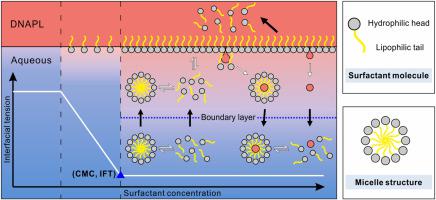Chemosphere ( IF 8.1 ) Pub Date : 2023-09-04 , DOI: 10.1016/j.chemosphere.2023.140071 Zejun Wang 1 , Zhibing Yang 1 , Yi-Feng Chen 1

|
Surfactant-enhanced aquifer remediation has been proved successful to remove dense non-aqueous phase liquids (DNAPLs) from contaminated sites. However, the underlying mechanisms of the DNAPL mobilization and solubilization at the pore scale remains to be addressed for efficient application to the field remediation system. In this work, the emerging microfluidic and imaging technologies are applied to investigate the dynamics of DNAPL remediation. Visualized experiments of the evolution of DNAPL remediation are performed to study the role of surfactant type, concentration and injection rate. The DNAPL remediation is dominated by mobilization followed by solubilization for most surfactants. Mobilization occurs as soon as surfactants and DNAPL are in contact until forming a new stable phase structure, and the solubilization continues until the end of injection. We observe the breakup behavior of long droplets and ganglia during the mobilization, which is attributed to the surfactant-reduced interfacial tension and thus expedites DNAPL mobilization and redistribution. During the solubilization, the formation of micelles incorporating DNAPL fractions increases the DNAPL concentration gradient and thus enhances the mass transfer, but the rate-limited diffusion of micelles reduces the mass transfer rate coefficient. Increasing the surfactant content and decreasing the injection rate can promote mobilization and solubilization. The DNAPL mobilization ability of the surfactants SDS and SDBS is stronger than SAOS and Tween 80 regardless of the injection rates. Tween 80 may be considered an ideal surfactant of only solubilization but not mobilization is desired. This work elucidates the pore-scale mechanisms during surfactant-enhanced DNAPL remediation, which are beneficial for upscaling studies, predictive modeling, and operation optimization of DNAPL remediation in the field.
中文翻译:

表面活性剂增强 DNAPL 动员和溶解的孔径研究
事实证明,表面活性剂强化含水层修复可以成功去除污染场地中的浓密非水相液体(DNAPL)。然而,为了有效应用于现场修复系统,DNAPL在孔隙尺度上的动员和溶解的基本机制仍有待解决。在这项工作中,新兴的微流体和成像技术被应用于研究 DNAPL 修复的动力学。进行 DNAPL 修复演变的可视化实验,以研究表面活性剂类型、浓度和注入速率的作用。对于大多数表面活性剂来说,DNAPL 修复主要是动员,然后是溶解。一旦表面活性剂和 DNAPL 接触,就会发生动员,直到形成新的稳定相结构,并且溶解持续到注射结束。我们观察到长液滴和神经节在动员过程中的破碎行为,这是由于表面活性剂降低了界面张力,从而加速了 DNAPL 的动员和重新分布。在溶解过程中,掺入DNAPL组分的胶束的形成增加了DNAPL浓度梯度,从而增强了传质,但胶束的限速扩散降低了传质速率系数。增加表面活性剂含量并降低注射速率可以促进流动和溶解。无论注射速率如何,表面活性剂 SDS 和 SDBS 的 DNAPL 动员能力均强于 SAOS 和 Tween 80。吐温80可以被认为是一种理想的表面活性剂,仅需要增溶作用而不需要流动性。这项工作阐明了表面活性剂增强 DNAPL 修复过程中的孔隙尺度机制,这有利于现场 DNAPL 修复的升级研究、预测建模和操作优化。















































 京公网安备 11010802027423号
京公网安备 11010802027423号